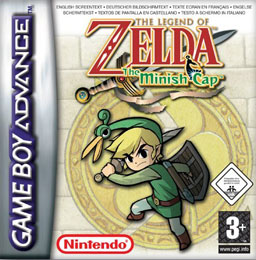714th played so far
Genre: Action/Adventure
Platform: Gameboy Advance
Year of Release: 2004
Developer: Capcom/Flagship
Publisher: Nintendo
In the past year or so, I’ve been playing a lot of The Legend of Zelda: Breath of the Wild, the Zelda game that combines the open world of an Assassins Creed game with the world of The Legend of Zelda and then strips down everything it doesn’t need (and adds plenty of bits it does need).
It feels weird, then, that I haven’t played one for the blog in a while (or perhaps not, I might have had enough already). One group I haven’t touched as much are the top down handheld installments, of which the Gameboy Advance and Nintendo DS had a few. Even more important, The Minish Cap is one of the games that came free with my early 3DS purchase, so I really ought to cover it.
Our Thoughts
The Legend of Zelda: The Minish Cap builds on a lot of elements from its predecessors. A Link to the Past is the obvious inspiration, the colourful graphics and world being closer than Link’s Awakening world which had a stripped down look by necessity. And here, too, it has it unique feature – or gimmick, if you will, and it’s hard to argue this isn’t one. Thanks to the Minish cap, a bird that perches on your head through most of the game, you can shrink to become the size of the Minish, a tiny people that lives in the forests and areas surrounding you. It creates an additional incentive to explore areas and a new way to solve puzzles, as well as some more inhabited areas than you often see in Zelda games. It’s not amazing, but it works quite well and follows on the Oracle series of doing things. Some other secondary elements get introduced as well – mostly focused on learning sword techniques and upgrading swords, as well as additional movement abilities, but it’s not the key focus as much, with the Minish cap really expanding the scope of the world.
This is reflected in the dungeons. The ones I saw, at least, were all small as well. This means, of course, that a lot of the dungeon scenery is more organic, with a barrel in the first dungeon being a clear nod to the size’s origin. The enemies, too, are ‘normal sized’ enemies that look large in this new world. It’s a nice touch and feels better than the inexplicably present, created dungeons in other games.
What’s most convincing are the charming graphics. This game was released after Wind Waker and it shows in the art style. It works well for a smaller screen, creating a clear look at what’s going on. I know it’s not universally popular, but it worked for me.
Final Thoughts
After Breath of the Wild, any Zelda game would suffer, but this is a decent installment – not one I’d necessarily put at the top, but it feels accessible and welcoming. There’s a feeling of some gimmickry being present, but it feels like there’s something for later DS games to build on.
